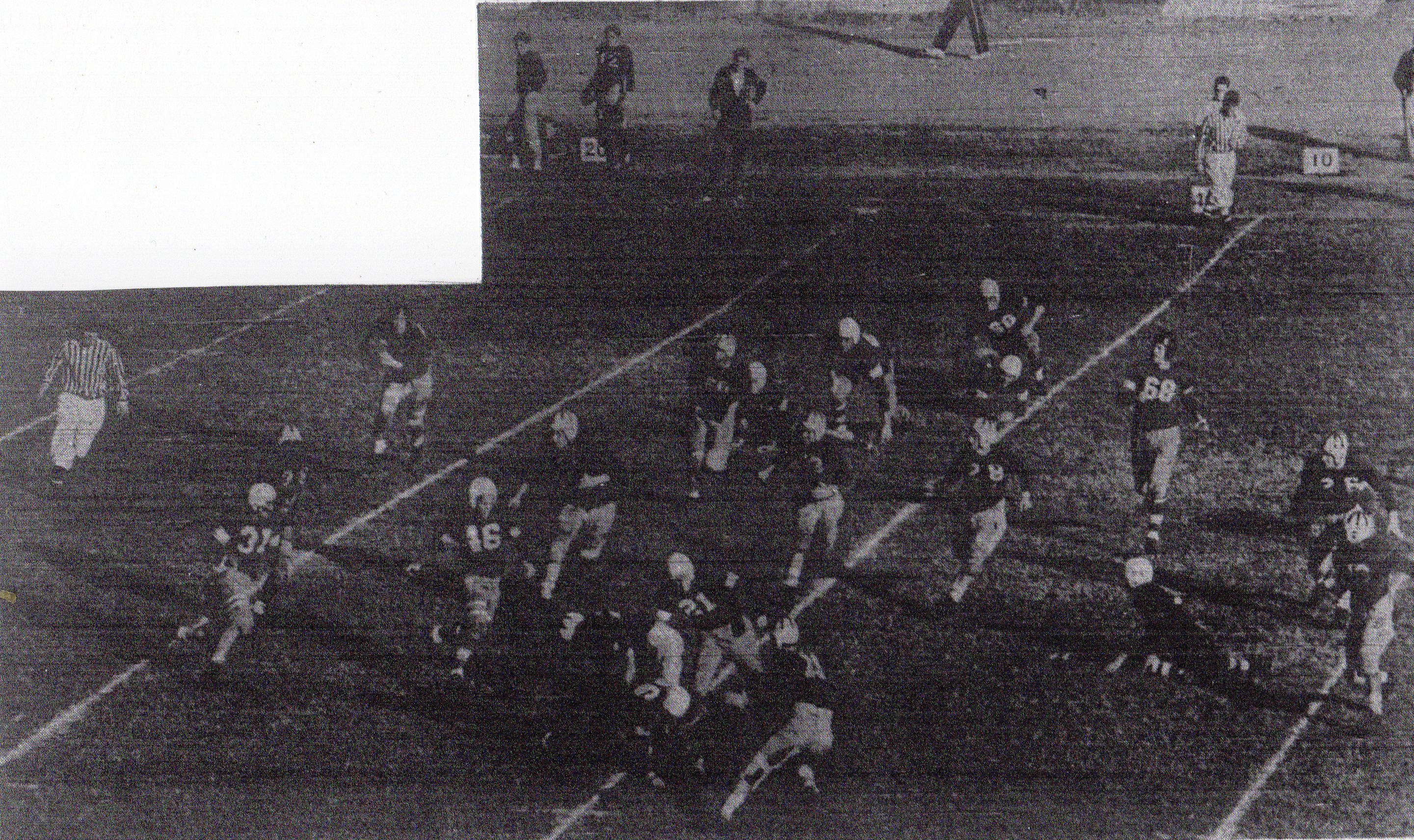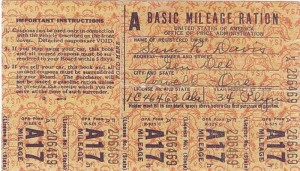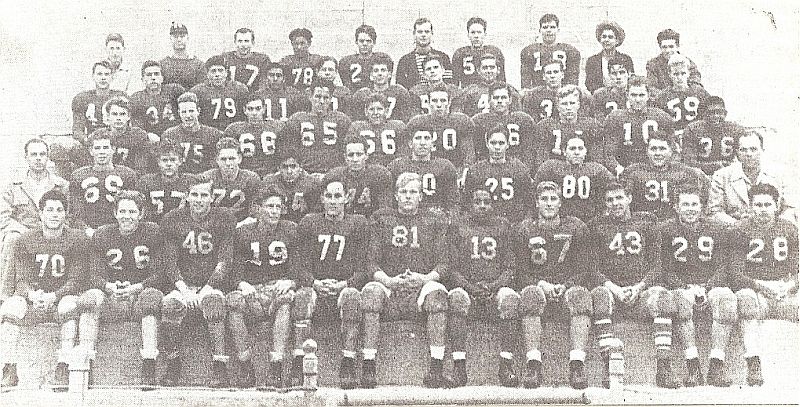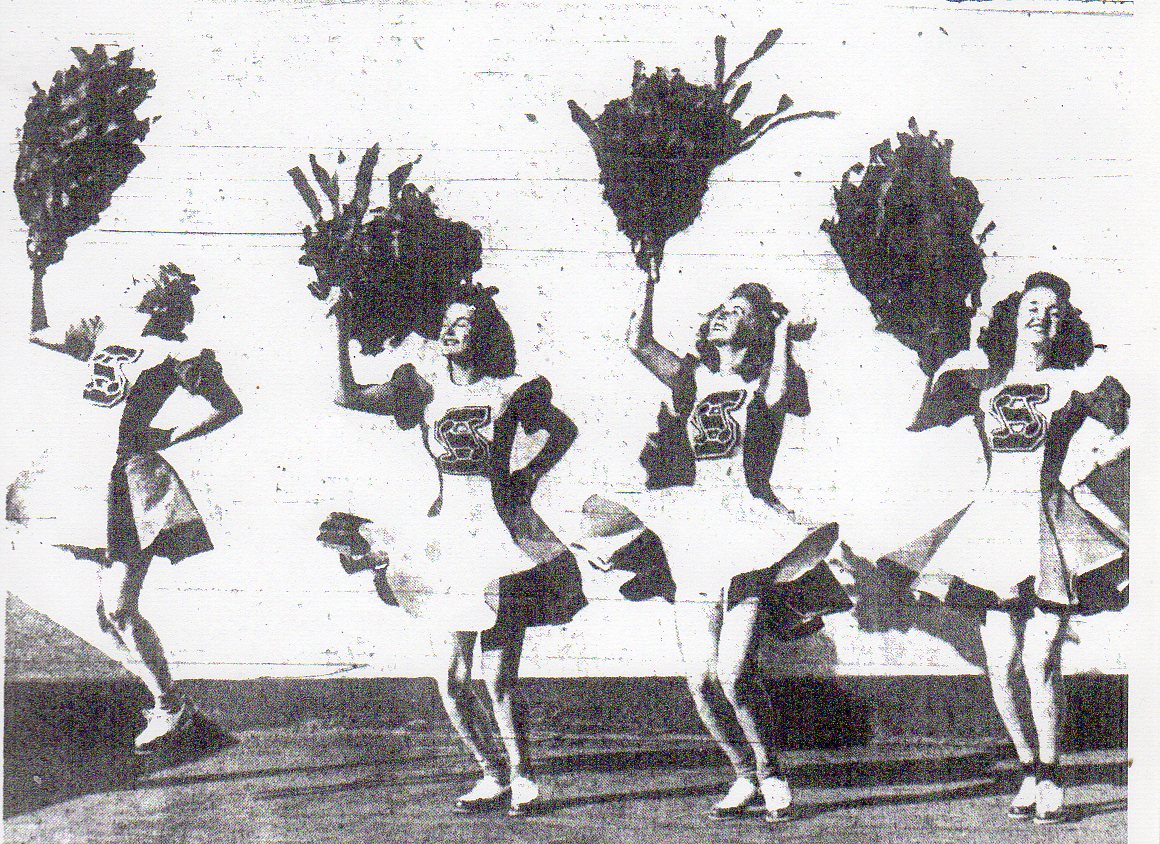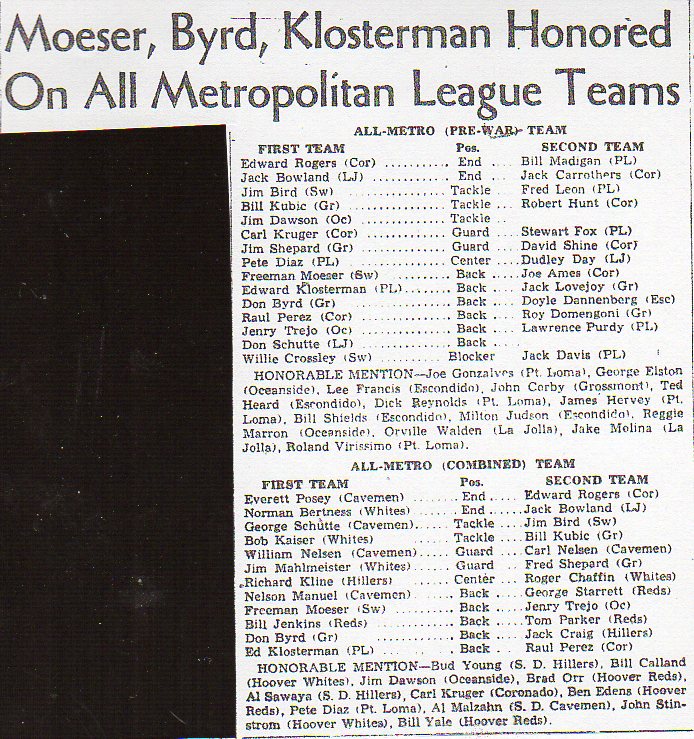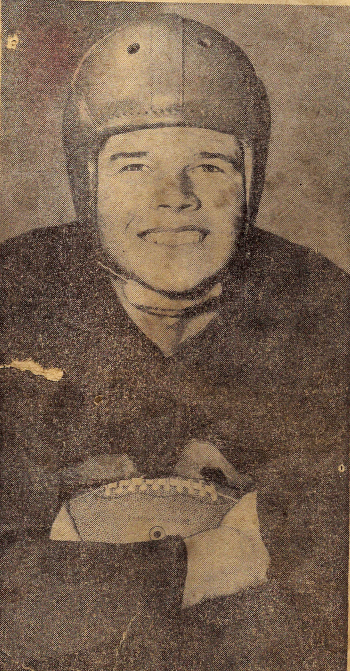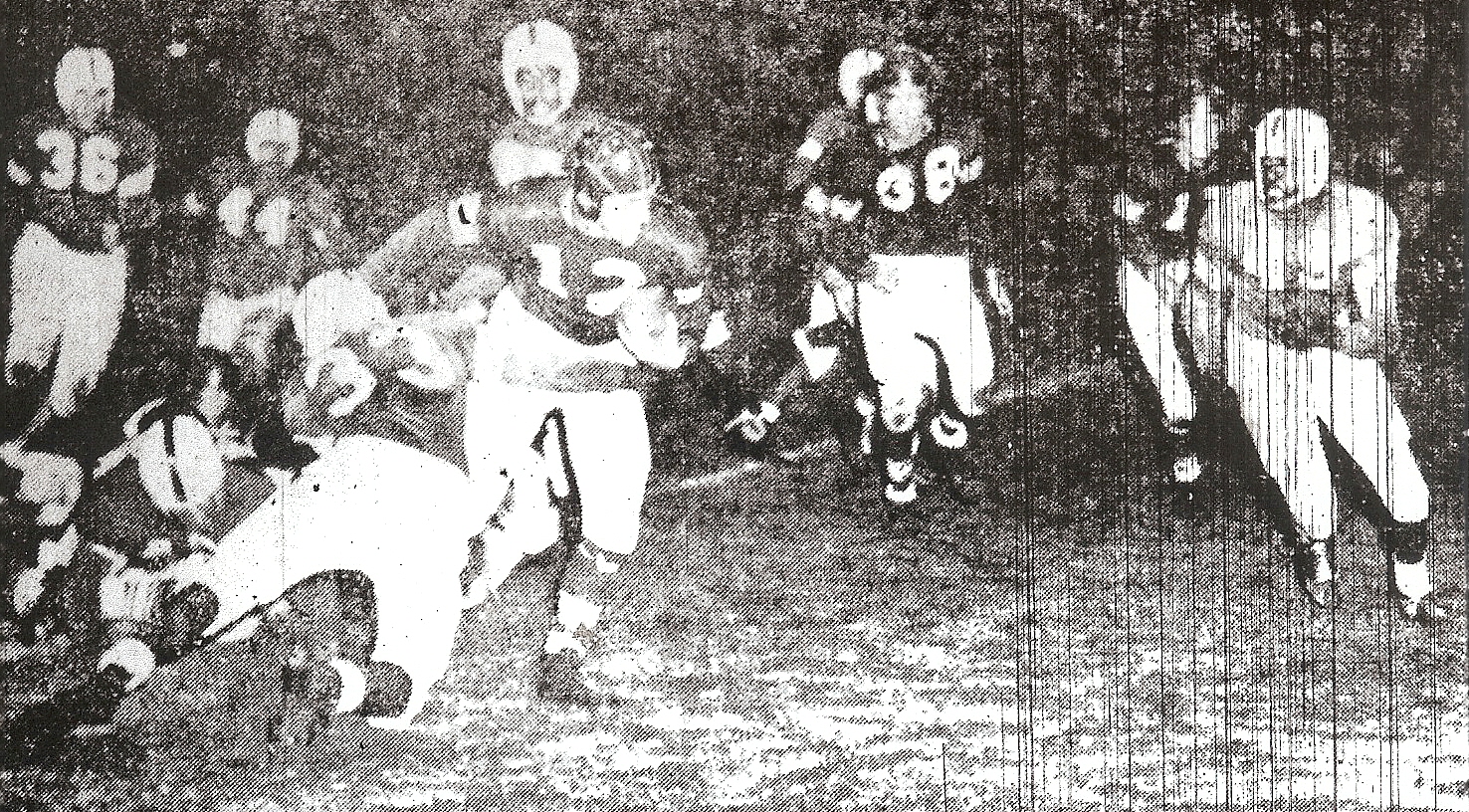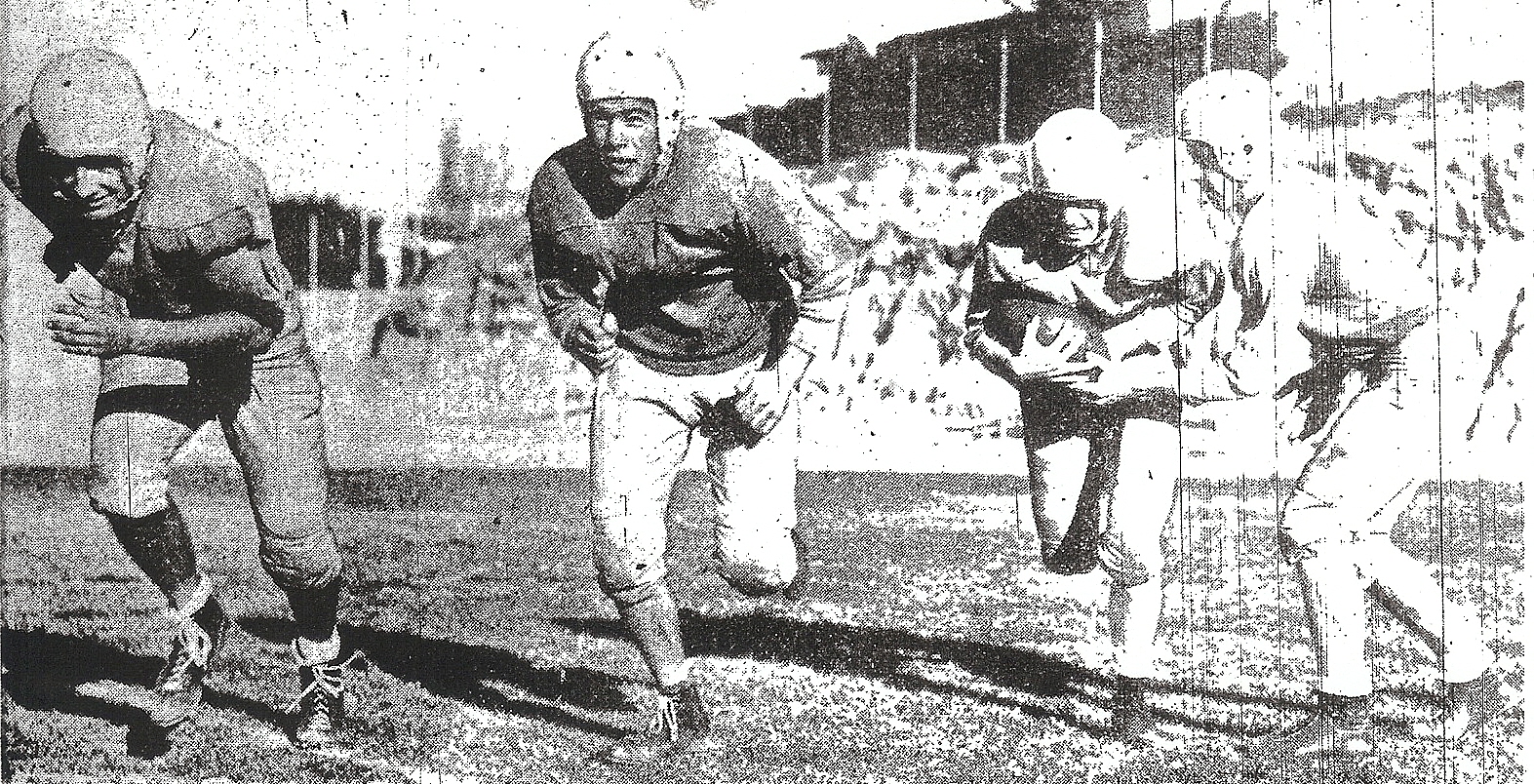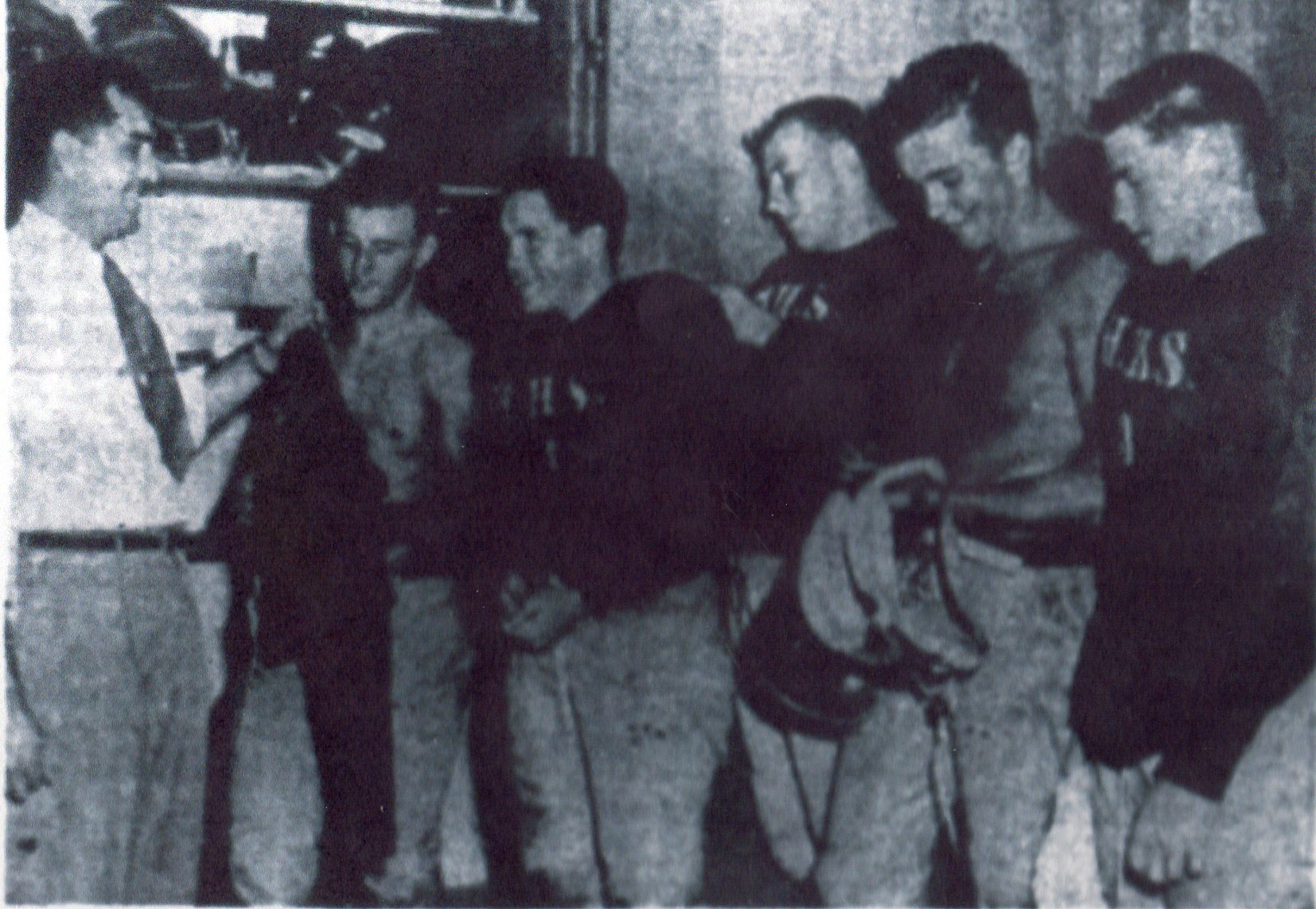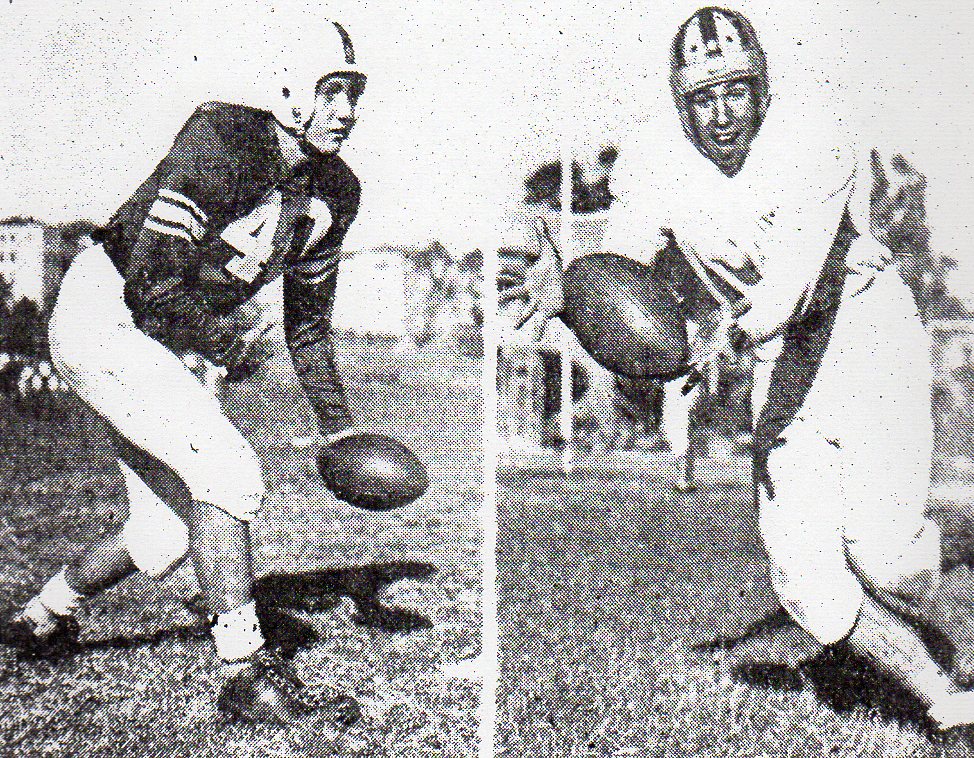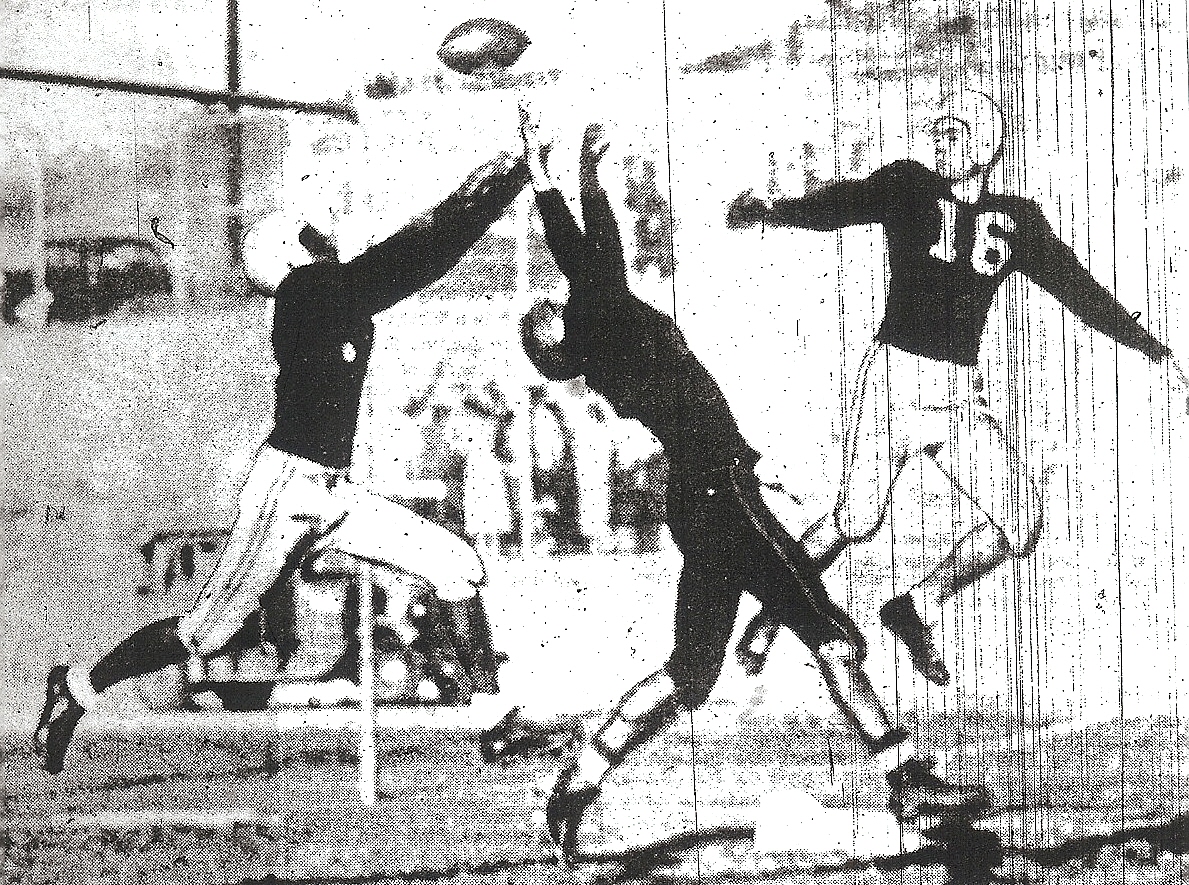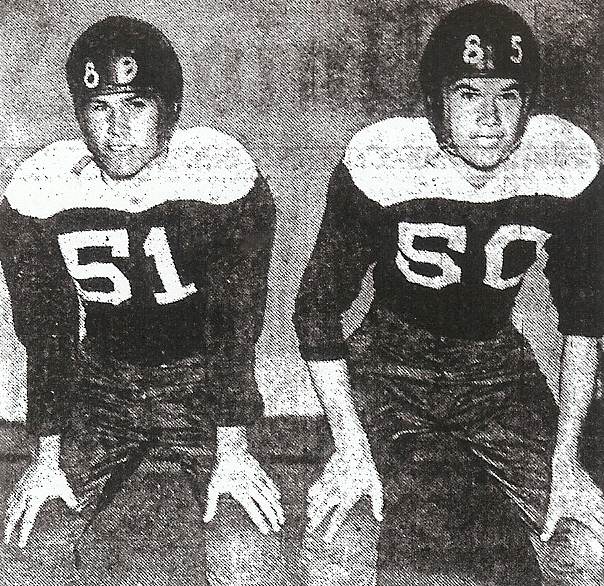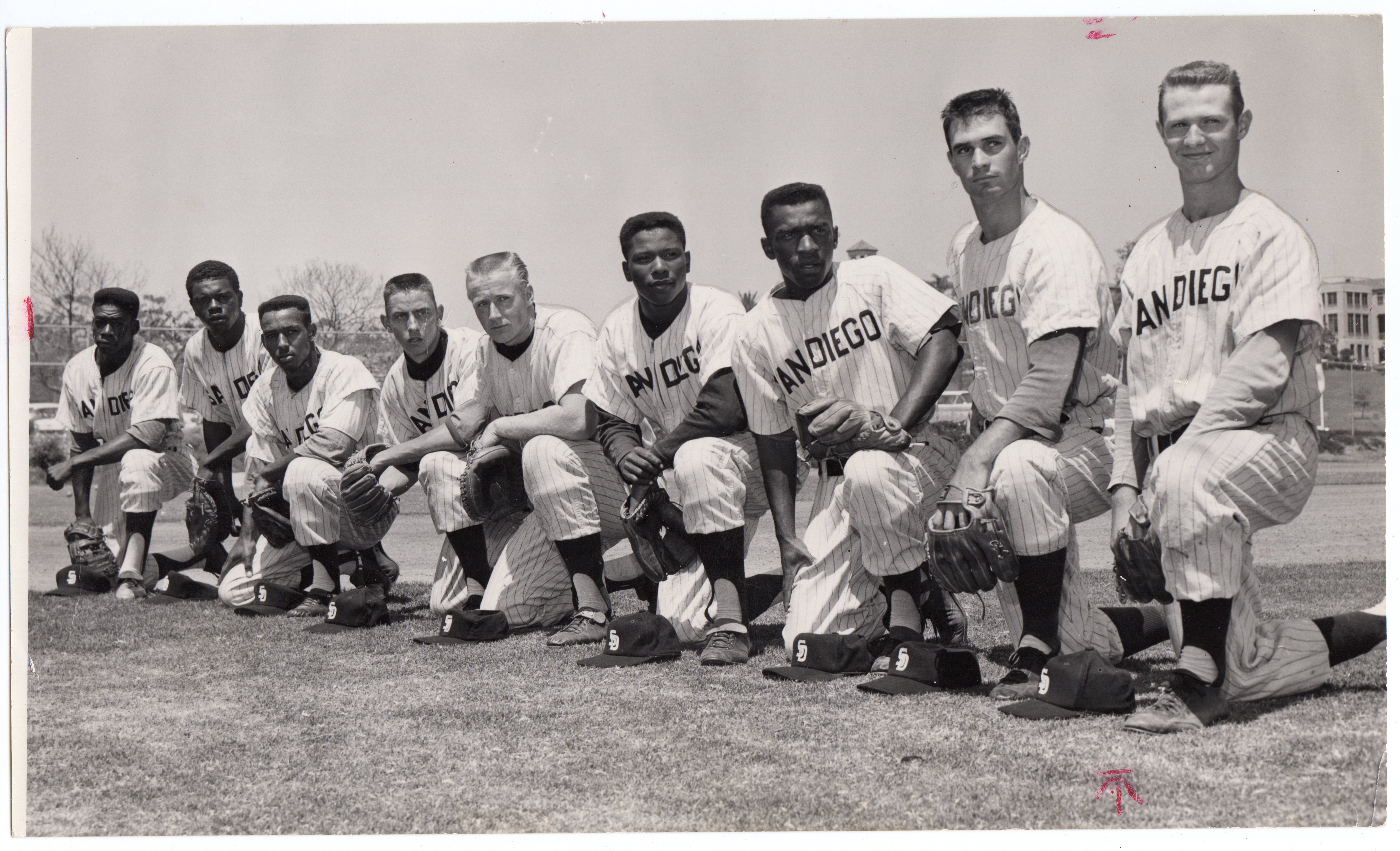1953: “Brimming” With Success
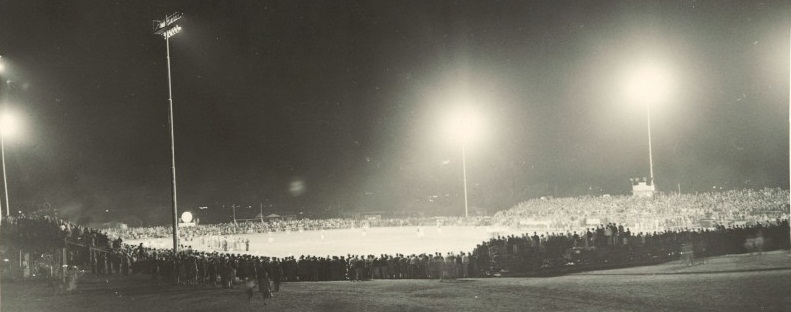
Chula Vista High was in the midst of a legendary era in the school’s history, thanks to two gentlemen loosely described by their imaginary headwear, which bespoke of the respect they commanded and clout they carried.
Joe Rindone, the sports-minded school principal and president of the CIF Southern Section executive committee, was known as the “Big Blue Hat”. Chet DeVore, whom Rindone appointed as the Spartans’ football coach in 1951, was the “Little Blue Hat”.
Blue and white were the colors of the school, which opened in 1946 at a temporary location in the Brown Field Air Station, near the U.S.-Mexico border. The campus, on its present site in west Chula Vista, welcomed students a year later.

Rindone and DeVore would leave lasting academic and sports legacies in San Diego and in the Sweetwater Union School District, and it started at Chula Vista, the second high school to be built south of the San Diego city limits. Sweetwater was the first, going all the way back to 1907, when it opened as National City School.
MANY FOLLOW
Chula Vista High came upon the scene at a time when the sprawling and still largely undeveloped South Bay region of San Diego began to experience the decades of growth and opportunity that followed World War II.
Ten more public high schools have since emerged: Mar Vista (1950), Hilltop (1959), Castle Park (1963), Bonita Vista (1967), Montgomery (1970), Southwest (1976), Eastlake (1992), Otay Ranch (2003), San Ysidro (2004), and Olympian (2006).
All 12 operate in three leagues under the umbrella of the Metropolitan Conference. Each has its own, mini-geographical rivalries but none match the tradition and, on occasion, fury of Chula Vista-Sweetwater, which have played each other every year since 1947.
DeVore, a San Diego State grad and decorated battlefield veteran of World War II, did not inherit a champion when he was selected to replace Morrie Shepherd as the Spartans’ third coach in the school’s first five years.
Chula Vista was 13-23-3 in its first four seasons, including a 1-3 record against Sweetwater.
FROM 1-3-1 TO 9-0
The coach’s original team started on an equally unimpressive note, shut out in four of the first five games and with a 1-3-1 record, but the Spartans closed at 4-4-1.
DeVore’s program took off in 1952, rolling to nine straight victories before a first-round, Southern Section lower division, playoff loss to Laguna Beach.
Metropolitan League title talk this season started and ended with the Spartans, but Sweetwater coach Barney Newlee also liked his chances. So did Oceanside’s John Simcox.
Sweetwater’s offense revolved around quarterback Don Magee, a Pala Indian whose brother, Dennis, was the team’s center. Don Magee passed for 18 touchdowns and directed the spread offense Newlee had adopted in mid-season 1952.
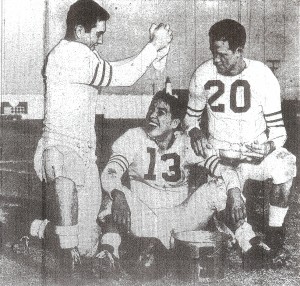
The Red Devils averaged 29 points with the new look and won four of their last five games, including a 14-13 loss to Chula Vista.
BEWARE THE ROBOT
But the most explosive and dangerous opponent lurked in the Northern reaches of the league, almost 50 miles away at Oceanside, home of C.R. Roberts, one of the top prep running backs in the country.
Roberts scored 31 touchdowns in the first eight games in 1952, running through and around every team on the schedule until he faced the Spartans, who swarmed the 200-pound “Robot” in a 28-7 victory that clinched the Metropolitan League championship.
Chula Vista’s win was tribute to a defense that hounded Roberts virtually from the moment he walked out of the Pirates’ locker room. Roberts scored Oceanside’s only touchdown but had 11 blue and white escorts wherever he went.
The encore was 30 touchdowns in the first eight games of 1953, Oceanside and Roberts bearing down again on another championship-deciding game with Chula Vista.
“Robot” was a play on what many thought was Roberts’ middle initial. “Oceanside Express” also was popular, as was “Chain Reaction”. He seldom was called Cornelius, his first name. There was no middle name. The initial actually was for his last name.
MR. TOUCHDOWN!
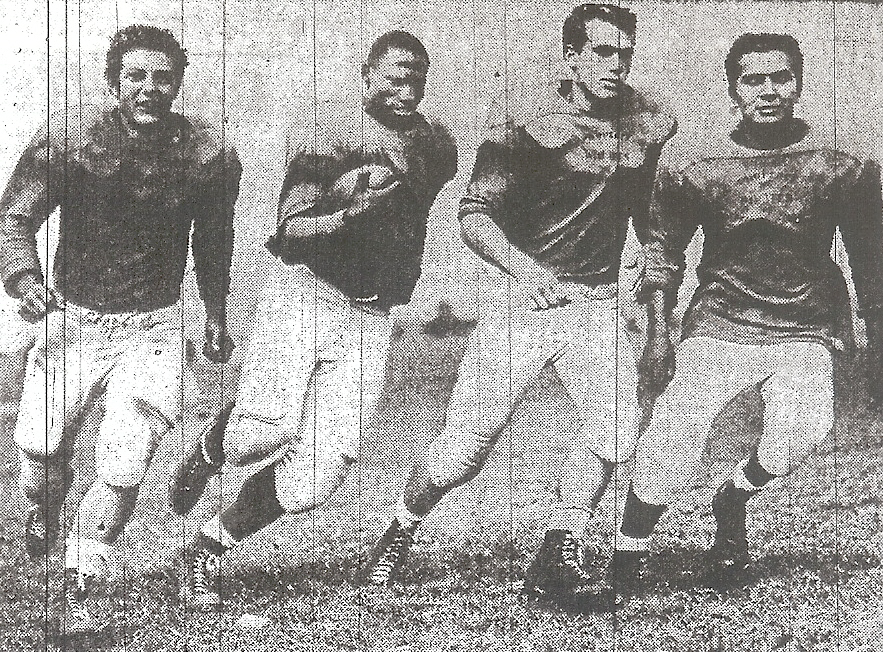
While rolling out 10 touchdown dashes at distances of 60 to 86 yards and a reported record season of 1,903 rushing yards in nine games, Roberts:
— Singlehandedly outscored Mar Vista 38-0 with 274 yards rushing and five touchdowns and passed 66 yards for another score;
–Scored 33 points and rushed for 331 of Oceanside’s 369 yards on the ground in a 40-19 victory over Escondido;
–Rushed for 317 yards in 28 carries and scored five touchdowns in a 41-6 rout of San Dieguito;
–Scored from 60, 46, 61, 59, and 62 yards in a 52-13 rout of Vista;
–Passed for seven touchdowns including strikes of 81, 66, 55, and 54 yards.
Roberts also was the president of his Sunday School group in junior high, graduated near the top of his senior class at the then-named Oceanside-Carlsbad, was president of his USC fraternity, and helped integrate the university’s Fraternity Row.
As the first African-American to play in an athletic event against the University of Texas in Austin in 1956, Roberts left the Longhorns pawing dust. He was in the game for only 12 minutes but rushed for 251 yards and 3 touchdowns in a 44-20 USC victory and was cheered by the home crowd as he left the field.
A sprinter and jumper in the spring , Roberts leaped 24 feet, 3 ½ inches, to beat favored Rafer Johnson in the annual UCLA-USC dual track meet. He played four seasons in the NFL with the San Francisco 49ers and also played in the Canadian League.
Between football seasons Roberts graduated from USC with a degree in business administration.
Many Spartans who faced Roberts in 1952 would face him again, including 16 lettermen entering the season.
Veteran tackle Don Dickerson anchored the defense and running backs Bob Neeley and Benny Martin were all-league holdovers. Bob Franklin moved from defense and became a solid quarterback.
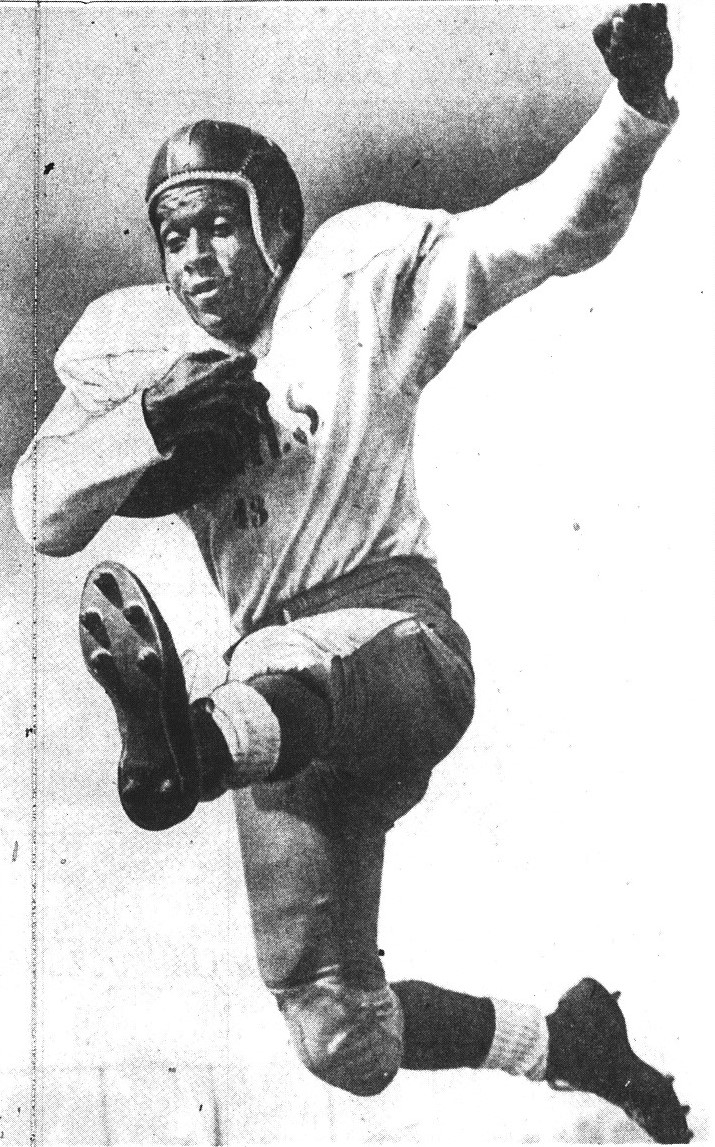
WHERE’S FIRE MARSHAL?
Both teams were 7-0.The Chula Vista community was agog. Tickets to the game were tougher to come by than a seat for a 3-D movie at the Vogue Theater.
Rindone had bleachers installed around the Spartans’ field for an additional 1,200 persons. An overflow crowd that included rows of standees was said to be 10,000 persons.
Roberts was held to 35 yards. Chula Vista won again 14-0 and clinched a second consecutive Metropolitan League championship.
There was one statistic, however, that reflected Roberts’ grit. He never stopped coming at the Spartans, carrying the ball 29 times, on each pressured and hammered by DeVore’s fast, hard-hitting defenders, who dominated the Oceanside forwards.
The victory not only clinched another Metropolitan League crown but meant that Chula Vista had defeated its principal rivals on successive weeks. Seven days before it took care of Sweetwater 28-13.
The Spartans earned a first-round, CIF lower division playoff bye with their 9-0 record. Rindone won a telephonic coin flip conducted in the CIF office in Los Angeles and Chula Vista was host to a quarterfinals matchup against 6-2 Corona.
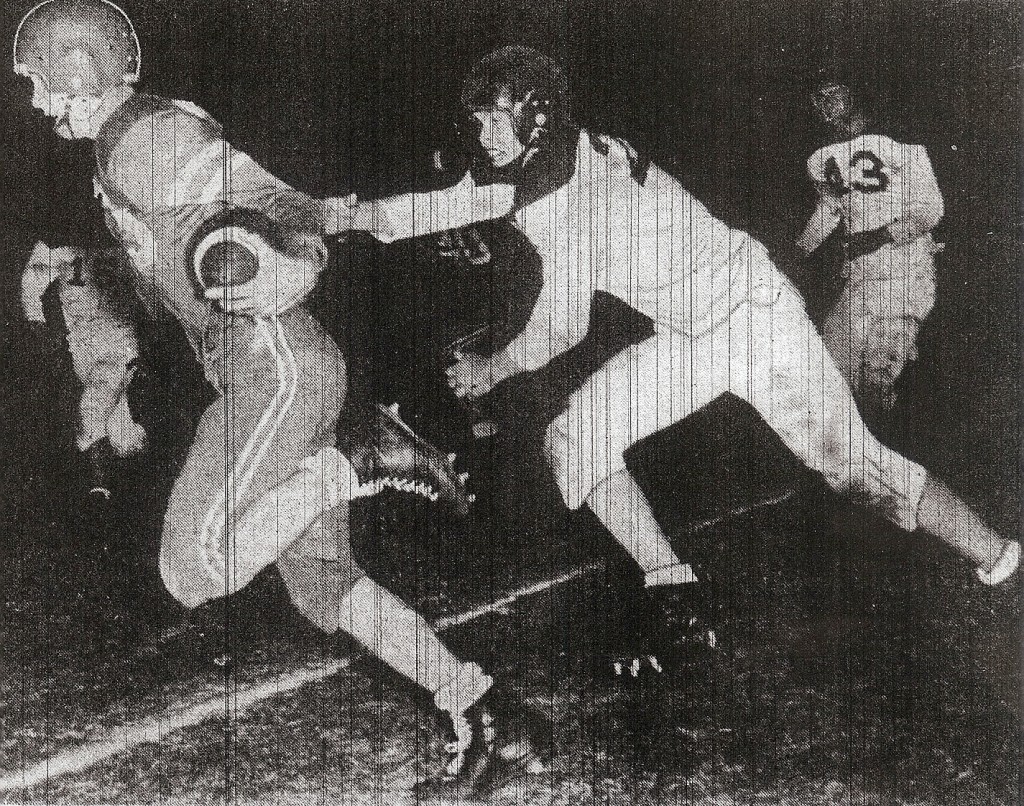
The Spartans had beaten Bonita 54-7 in the season opener and Bonita later defeated Corona 18-13. It looked like an easy first test for the Metropolitan League champs.
CLOSE, BUT NO CIGAR
Comparative scores meant nothing.
Corona scored first in the second quarter before another overflow crowd of 5,000. The Panthers kept the Spartans at a distance.
The Panthers led, 7-6, deep into the second half, before the Spartans braced and took possession with 4:39 remaining in the game, the ball on their 12-yard line.
Spartans faithful shifted nervously in the packed bleachers.
The scoreboard clock ticking away, Chula Vista slowly moved down the field into scoring position.
Bob Franklin’s four-yard touchdown pass to Carroll Clowers on the ninth play of the drive came with only 15 seconds remaining and pulled out a 13-7 win.

Chula Vista held on for a 19-18 triumph the next week at Fullerton Junior College in the semifinals against favored Brea-Olinda, which was 10-0 and averaging 31 points a game.
Deadlocked, 6-6, at halftime, Chula Vista struck with the third-quarter kickoff. Bob Neeley accepted the kick of his 17-yard line, advanced to the 30, and then lateraled to Benny Martin, who covered the remaining 70 yards.
A recovered fumble on the Wildcats’ 30 led to Ron Mesker’s 11-yard touchdown run and Bob Wilson’s conversion put the visitors in front, 19-6.
Chula Vista held off the Wildcats before 3,500 chilled observers and reached the championship game by the margin of one successful point after and three Brea misses.
Two Wildcat conversions were blocked, by Fred McLean and Wayne Eisenman, the latter after a made Brea attempt was negated by a penalty.
The Spartans then were awarded home field again against another team of Wildcats, Brawley, the 1951 and ’52 CIF champion.
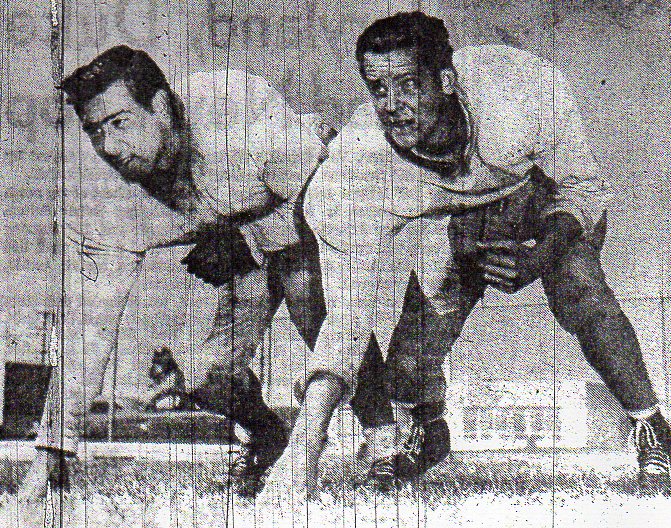
Chula Vista’s 12-6 victory over the Imperial Valley Wildcats before a crowd guessed at 7,500 completed a 12-0 season that was the best by a County squad since San Diego High’s Wonder Team of 1916 went 12-0.
Could the Spartans have beaten San Diego or Kearny, the two powers of the mighty City Prep League? It was a question that wouldn’t be answered, but South Bay partisans pondered the issue long into the winter.
COACHES’ SONS MEET C.R.
Fast forward almost 60 years. DeVore and Roberts were among the inductees in the CIF San Diego Section’s inaugural Hall of Fame class. Two younger men approached Roberts as he entered the event at San Diego’s Joseph Jacobs Center on May 22, 2011.
“Mr. Roberts,” said one, “I’m John DeVore and this is my brother James.” The sons of Chet DeVore had heard their late father speak of C.R. Roberts so often while they were growing up that the introduction was more like a meeting with an old friend.
“HATS” MOVE ON

Joe Rindone also supervised the creation of Southwestern College in Chula Vista in 1960. Chet DeVore, after retiring as coach following the 1955 season, followed Rindone as Chula Vista’s principal and later was President of Southwestern College.
DeVore was never far from football. He founded the Pacific Southwest Conference of junior colleges and worked for years as a football game official in San Diego County.
DeVore’s son John, was a longtime high school principal in the Sweetwater district and head football coach at Montgomery.
Chet DeVore’s won loss record in five seasons was 44-7-1, a percentage of .856, based on the formula of half game won and half game lost for ties. Duane Maley was 97-19-3 (.828) at San Diego High.
CANDIDATES?
Duane Maley and Don Giddings had been so successful on the high school level that they were among the first names mentioned when a head coaching vacancy opened at San Diego Junior College this year. Knights coach John Brose stepped down to become the school’s registrar.
Giddings and Maley, however, remained at their respective posts and San Diego JC chose ex-Hoover assistant and former Hilltopper George Schutte.
OMEN? WHAT OMEN?
For the first time in three years the San Diego Cavemen made the right call… there was no call to make
The Cavemen earned the right to host a quarterfinals playoff game with Anaheim, after losing coin flips for City Prep League playoff invitations in 1951 and 1952.
The Cavers shut out Kearny, 27-0, for the CPL championship on the final regular-season Friday but bombed in the playoffs.
After a first-round bye the Cavers were knocked out by Anaheim, 21-7.
The Anaheim Bulletin reported that the small but quick Colonists defeated the favored but “bewildered San Diego team”.
The Cavers’ defensive line outweighed Anaheim’s offensive line by 24 pounds.
Anaheim tied Santa Monica 21-21 in the semifinal round the next week but was eliminated by the quirky CIF rule favoring the team with the most first downs. Santa Monica had 15 to the Colonists’ 14 and moved on to defend its championship with a 34-19 win over Whittier.
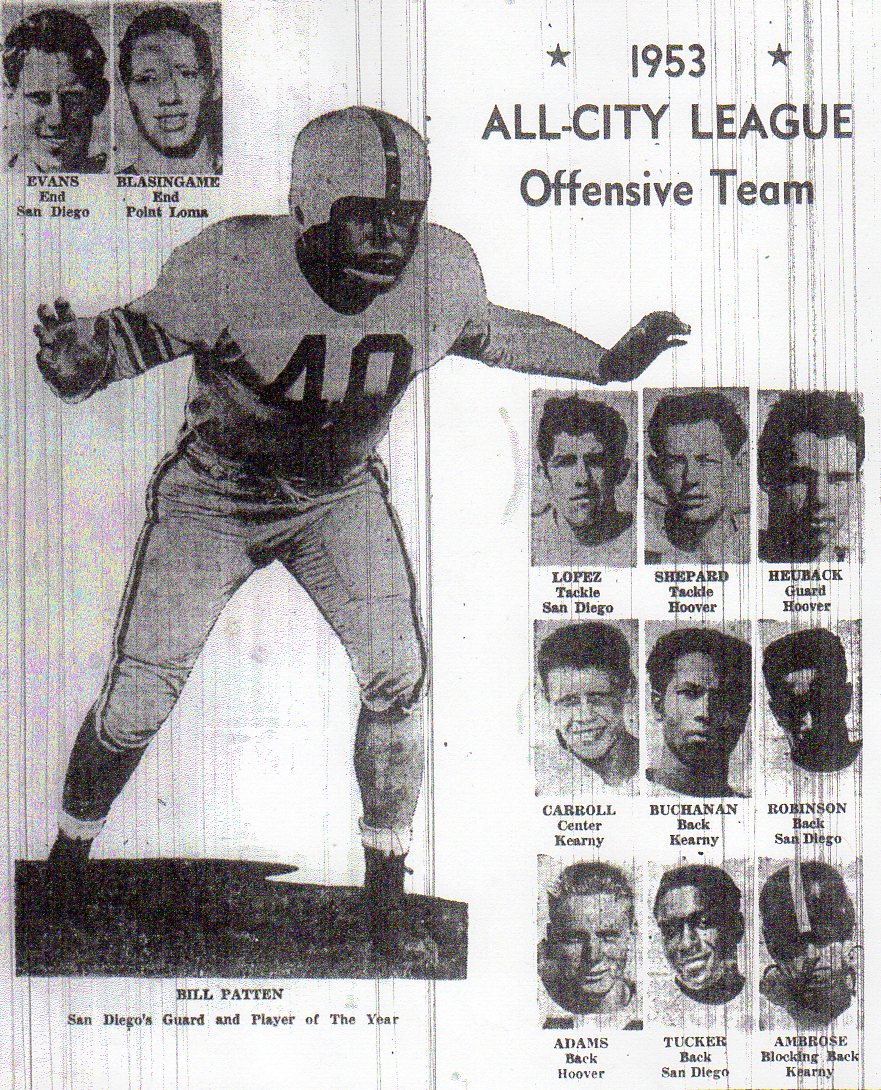
ZAMPESE FAMILIAR NAME
The Southern California player of the year was Santa Barbara tailback Ernie Zampese, who retired to San Diego after a long coaching career with San Diego State, the San Diego Chargers, Los Angeles and St. Louis Rams, New England Patriots, and Dallas Cowboys.
Zampese scored two touchdowns as Santa Barbara defeated Point Loma 26-0 in the final regular-season game.
DON’T INVITE ‘EM
There was no love lost between San Diego and Point Loma, especially after Pointers football and track standout Herman Thompson transferred to San Diego.
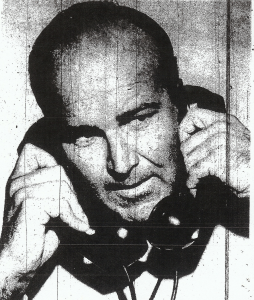
Nor did Pointers coach Don Giddings, a San Diego High graduate, want to compare San Diego and Kearny as those two prepared for their CPL title-deciding contest.
Giddings did allow that San Diego was “not the toughest team we’ve played this season”. The Komets had whipped Point Loma 27-7.
The Thompson transfer was provoking enough but Giddings also had to live with another, bitter loss to San Diego. Point Loma outgained Duane Maley’s team, 192-170.
San Diego was held to 102 yards rushing but still won 14-6, the Cavers’ defense stiffening in the fourth quarter, when Point Loma ran 27 offensive plays to San Diego’s five.
Point Loma tried a successful on-side kickoff and installed a four-man defensive line and called it the “Horseshoe Defense” against San Diego. Tackles and ends were on the line, guards and linebackers three yards off the line.
Essentially the Pointers went to a 4-4-3 alignment, the object being to contain San Diego’s dangerous, open field ball carriers once they cleared the first line of defense.
SCHEDULES ITSELF
Grossmont’s game at Colton was canceled because a Yellowjackets player came down with polio.
Grossmont coach Phil Morrell then scheduled an intrasquad scrimmage, proceeds going to purchase of new band uniforms. “This is one game I know we’ll win,” said Morrell.
Wrong! The Foothillers’ Blue tied the Foothillers’ gold, three touchdowns each.

REGIONAL VENUES?
City Schools officials discussed an idea of constructing two regional, lighted, concrete stadiums, one in the West for Point Loma, La Jolla, and Mission Bay, and another in the East for Hoover and Kearny. Lincoln and San Diego would share Balboa Stadium.
The idea was dismissed because of financing and fans’ desire to have their teams play on their own campus fields.
Improvement was made at Balboa Stadium, which introduced a new, electronic scoreboard that was 12 feet high, 25 feet wide, and 40 feet above ground.
BUILDING BLOCKS
San Diego’s junior varsity was undefeated and would provide the nucleus for the 1955 CIF Southern Section championship squad. Deron Johnson picked up a fumble and rambled 60 yards for the only score against the Lincoln “varsity” and was promoted to the Cavers’ varsity after that game.
Quarterback Pete Gumina passed 40 yards to Willie West for the winning touchdown in another game. Johnson, Gumina, and West made the all-SCIF first team two seasons later.

HONORS
San Diego guard Bill Patten earned a first-team selection on the all-Southern California squad. End Lauro Saraspe of La Jolla, tackle David Lopez of San Diego and halfback Lee Buchanan were on the third team.
Small-schools all-Southern California selections were player-of-the-year C.R. Roberts, joined on the first team by guard Fred McLean and halfback Bob Neeley of Chula Vista. Center Stan Nichols of Escondido made the second team.
QUICK KICKS
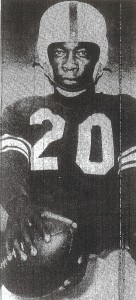
San Diego quarterback Floyd Robinson was better known as a nine-season major league outfielder mostly with the Chicago White Sox…Robinson had a .283 lifetime batting average and drove in 109 runs and batted .312 in 1962… San Diego had six players score at least 5 touchdowns, with total points in parenthesis: Horace Tucker (40), Ermon Johnson (38), Floyd Robinson (36), Dallas Evans (36), Herman Thompson (36), and Tony Asaro (30)…Kearny’s 7-1 record was the best in school history…beginning in 1944, the Komets were 21-43-5 through 1952… Hoover’s season, which started with great promise, ended with a 39-0 loss to San Diego and 7-7 tie with La Jolla… the Cardinals played San Diego in the annual city schools’carnival on Friday night and were forced to travel the next day to Santa Monica, where the Cardinals played the defending champions tough, losing 28-20, with the Vikings’ final touchdown coming on the last play of the game… Hoover scored 24 points in the fourth quarter of a 44-0 victory over San Bernardino the next week and smashed Grossmont 60-6 in Week 3…East teams Helix, Kearny, and San Diego defeated the West of Hoover, Point Loma, and La Jolla 7-2 before a football carnival gathering of 18,000 in Balboa Stadium… with its new, campus stadium still under construction, Sweetwater’s home games were at Aztec Bowl on the San Diego State campus and preseason drills at Mar Vista, 10 miles South… the new Lincoln High, with 10th and 11 graders (and junior high of grades 7, 8, and 9), did not participate in the football carnival but took part in the pregame pageantry… Lincoln was 6-1-1 against predominantly junior varsity competition… another new school, Mission Bay, with 10th and 11th graders was 3-3 against a similar schedule…Chula Vista’s bus trip to Fullerton for its game with Brea-Olinda began at 2:30 p.m…the Spartans stopped in San Juan Capistrano, a favorite resting locale of local teams headed north, for their pregame meal…although favored, Brea-Olinda’s student body numbered only 225, compared to Chula Vista’s, which was near 1,000…
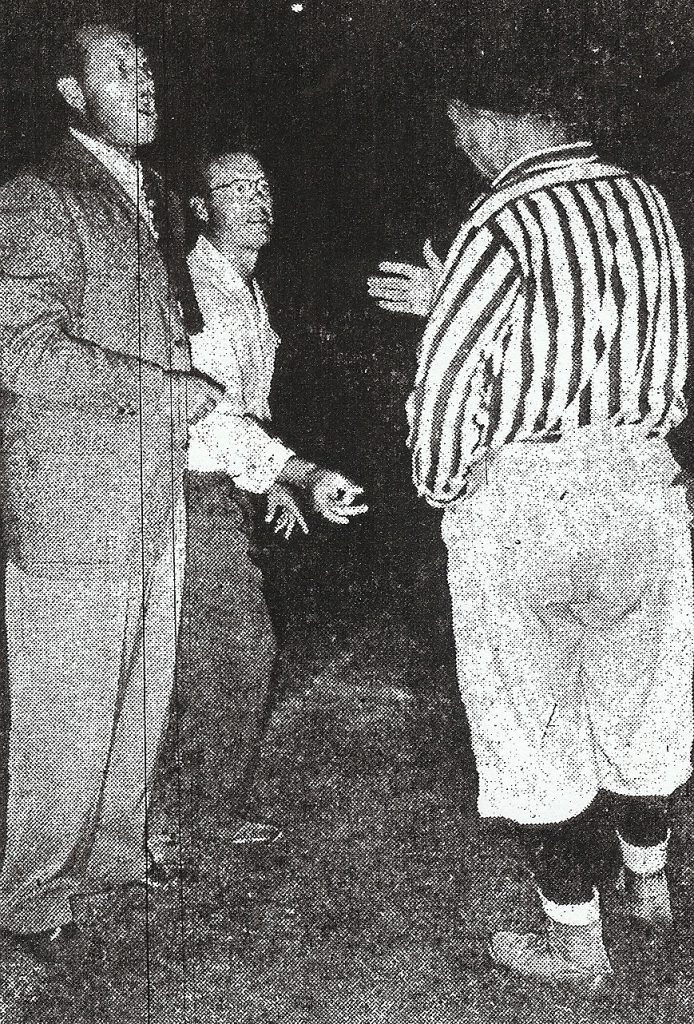
…Art Luppino of La Jolla rushed for 95 yards scored two touchdowns and was named the “Star of Stars” in the annual Breitbard College Prep game before about 16,000 in Balboa Stadium…the game, marking the beginning of the 1953 season, featured a team of graduated high school all-stars from the Los Angeles City Section and another from the CIF Southern Section…the L.A. City team scored a 24-13 victory…San Diego and Anaheim each lost to Redlands, which defeated the Colonists, 7-0, and San Diego, 14-7…The Cavers and Colonists also had lost coin flips for playoff berths in 1952 after tying for league championships….


